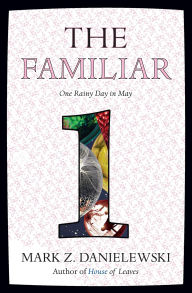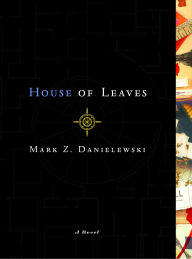Whatever Happened to Mark Z. Danielewski’s The Familiar?
 The Familiar was supposed to be a magnum opus: an ambitious serial novel told in twenty-seven massive volumes, split into five “seasons” of five books apiece, all written by renowned experimental writer Mark Z. Danielewski, author of the ergodic horror classic House of Leaves.
The Familiar was supposed to be a magnum opus: an ambitious serial novel told in twenty-seven massive volumes, split into five “seasons” of five books apiece, all written by renowned experimental writer Mark Z. Danielewski, author of the ergodic horror classic House of Leaves.
The Familiar, Volume 1: One Rainy Day in May
The Familiar, Volume 1: One Rainy Day in May
Paperback $28.95
As it was Danielewski’s first new book in eleven years (barring a reissue of his ghost story/puppet show script The Fifty Year Sword), publishing was pre-sold on the concept (the deal for the first 10 books of the saga exceeded seven figures), and lovers of weird fiction and experimental writing alike awaited it with anticipation. The plan was for new volumes to arrive at four-month intervals, and the first was released in June of 2015.
As it was Danielewski’s first new book in eleven years (barring a reissue of his ghost story/puppet show script The Fifty Year Sword), publishing was pre-sold on the concept (the deal for the first 10 books of the saga exceeded seven figures), and lovers of weird fiction and experimental writing alike awaited it with anticipation. The plan was for new volumes to arrive at four-month intervals, and the first was released in June of 2015.
But two years later, only five volumes had made it to bookstores, and that would turn out to be the end of it: the project was placed on indefinite hiatus, and Danielewski moved on to a picture book called The Little Blue Kite. But the fate of The Familiar—and the books themselves—are important, not just because of how the project ended, but because it existed in the first place.
Before we get into the what and the why, a bit of background: The Familiar is a serial novel about a teenager named Xanther and the unusual stray cat she finds. It features an immense cast of characters, from computer hackers and programmers, to gang members, a shady faith healer and her assistant, various animals, and the artificial intelligences known as NarCons who control the story. It’s a vast, dense, and strange set of books, with color-coded narrators, weird interludes, and Danielewski’s trademark textual experimentation. As the plot unfolds, it shifts genres and narrative styles, each chapter picking up where the last left off, revealing a little more as it chugs along. It’s a complex series to be sure, each volume a densely packed series of words and images that always hints at something more that what is actually there. To read it is to catch a glimpse of the greater scope and a more intricate plot.
According to social media posts by Danielewski himself, publisher Pantheon ended the series due to the cost of publication not keeping up with the reader base. This is kind of a mundane explanation, but an understandable one: the audience for Danielewski’s books has always been, well, specific at best—willing to follow him through textual experiments, odd metanarrative conceits, and offbeat artistic decisions—and finding faithful readers willing to do so for 27 volumes was always going to be a tall order.
The Familiar is also a series that forces active, close, multiple reads, as it requires you to wade through its cryptic narrative and engage on multiple levels. It’s not the kind of book everyone could love, though those able to get into it and vibe with it will love it fiercely. It’s not surprising it wasn’t widely adopted by readers.
House of Leaves (Remastered Full-Color Edition)
House of Leaves (Remastered Full-Color Edition)
In Stock Online
Paperback $29.00
The books themselves—huge, glossy, full-color affairs half the length of the average Peter F. Hamilton novel and sporting a ribbon bookmark—could not have been particularly cheap to print, either. Our review of the first volume even says as much, likening the book to and art object rather than a conventional novel. But though this may be a fine way to present the dense plot, using varied printing techniques to highlight switches between narrators, it also foregrounds their penchant for wild experimentation, perhaps suggesting a reading experience that will veer into the impenetrable more than the complex. The books are gorgeous, but when it takes almost two hundred pages to introduce the first set of narrators, it’s not difficult to see why people may have balked at lugging them around (not to mention devoting an entire bookshelf to them). It’s also difficult to keep people invested in a series when, even with “season breaks,” the full story won’t conclude for over a decade, even at the accelerated rate at which The Familiar was released.
The books themselves—huge, glossy, full-color affairs half the length of the average Peter F. Hamilton novel and sporting a ribbon bookmark—could not have been particularly cheap to print, either. Our review of the first volume even says as much, likening the book to and art object rather than a conventional novel. But though this may be a fine way to present the dense plot, using varied printing techniques to highlight switches between narrators, it also foregrounds their penchant for wild experimentation, perhaps suggesting a reading experience that will veer into the impenetrable more than the complex. The books are gorgeous, but when it takes almost two hundred pages to introduce the first set of narrators, it’s not difficult to see why people may have balked at lugging them around (not to mention devoting an entire bookshelf to them). It’s also difficult to keep people invested in a series when, even with “season breaks,” the full story won’t conclude for over a decade, even at the accelerated rate at which The Familiar was released.
It would be wrong, though, to allow failure bias to cloud the books’ accomplishments. Sure, it was a difficult series that struggled to find its audience, but looking at it today as an incomplete or failed experiment discounts its strengths. Across five massive novels, we were given a complex, multi-threaded narrative featuring an inclusive cast made up of multiple protagonists of color, several of them neurodiverse and three of them for whom English was a second language. Their experimentation with language and typography actually help convey this diversity, with Xanther’s intrusive thoughts and questions slowly filling up the pages, or her mother Astair’s nested parenthetical statements and line breaks mimicking the emotions of someone under a lot of stress and anxiety, who is experiencing racing thoughts. The Familiar creates understanding with its typography that can’t easily be communicated with mere words.
That The Familiar exists at all should be motivation enough for writers to try new ideas and push into weirder territory, to take those strange, messy, ambitious projects they think no one is interested in as far as possible. If a book series this weird, this challenging, this inclusive, and this unique can find any sort of traction, anything can. We should be celebrating that The Familiar was able to come to market at all, and taking it as a lesson that science fiction and fantasy works don’t have to be conventional to find an audience. It should be a call to readers that the next weird, convention-shattering book might be just around the corner.
Books of this sort can and should exist. And as writers, as readers, it’s our duty to make sure they do.
Explore The Familiar and the rest of Mark Z. Danielewski’s work.

